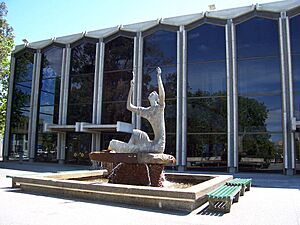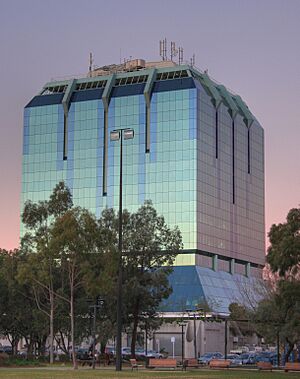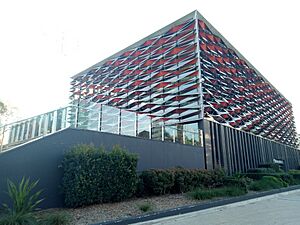City of Bankstown facts for kids
Quick facts for kids City of BankstownNew South Wales |
|||||||||||||||
|---|---|---|---|---|---|---|---|---|---|---|---|---|---|---|---|

Location in Metropolitan Sydney
|
|||||||||||||||
| Population | 193,398 (2011 census) (15th) | ||||||||||||||
| • Density | 2,374/km2 (6,150/sq mi) | ||||||||||||||
| Established | 7 September 1895 | ||||||||||||||
| Abolished | 12 May 2016 | ||||||||||||||
| Area | 76.8 km2 (29.7 sq mi) | ||||||||||||||
| Time zone | AEST (UTC+10) | ||||||||||||||
| • Summer (DST) | AEDT (UTC+11) | ||||||||||||||
| Mayor | Khal Asfour | ||||||||||||||
| Council seat | Bankstown | ||||||||||||||
| Region | Inner West | ||||||||||||||
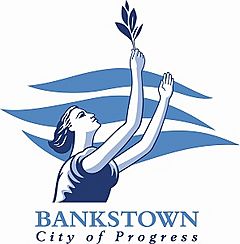 |
|||||||||||||||
| Website | City of Bankstown | ||||||||||||||
|
|||||||||||||||
The City of Bankstown was a local government area in the south-west of Sydney, Australia. It was centered around the suburb of Bankstown. This area existed from 1895 until 2016. The last mayor of the City of Bankstown Council was Khal Asfour.
In 2015, the NSW Government suggested that the City of Bankstown should join with the City of Canterbury. This merger would create a new council covering about 110 square kilometers. It would serve a population of around 351,000 people. On May 12, 2016, the NSW Government announced the merger. The new council became known as the City of Canterbury-Bankstown.
Contents
Suburbs of Bankstown
The City of Bankstown included many suburbs and areas. Here are some of them:
|
|
History of Bankstown
The area of Bankstown was named in 1797 by Governor Hunter. He named it after Sir Joseph Banks, a famous botanist. Banks traveled to Australia with Captain James Cook in 1770. The area was first explored by George Bass and Matthew Flinders along the Georges River.
The railway played a big part in Bankstown's growth. When the railway was extended to Bankstown in the 1890s, the area grew quickly. The main shopping area moved closer to the Bankstown railway station.
In 1895, residents asked the NSW Government to create the "Municipal District of Bankstown." This request was approved, and the district was officially formed on September 7, 1895. The first council was elected later that year. In 1906, it became the "Municipality of Bankstown."
Bankstown became a "City" in 1980. This was a special event, with Queen Elizabeth II present. The City of Bankstown continued until May 12, 2016, when it merged with the City of Canterbury.
Bankstown During World War II
During World War II, Bankstown had a secret bunker. This bunker was a copy of the underground rooms in England. These rooms helped direct fighter planes against German attacks. The Bankstown Bunker was hidden by a grassy slope. It had strong walls that could withstand a large bomb.
Bankstown Council Buildings
The Bankstown Council had different places where it met and worked over the years.
Early Council Chambers (1918)
In 1918, a new Council Chambers building opened on South Terrace. It cost £4,000 to build. This building was the main office for the council until 1963.
Civic Centre and Council Chambers (1963)
By the 1960s, the council needed a bigger headquarters. They wanted a new "civic center" for the area. In 1961, they chose a modern design by architect Kevin Curtin. This plan included an Administration Building, a round Council Chamber, and a Town Hall. The Council Chambers was the first part finished. It was shaped like a roundhouse.
Administration Building
The administration building opened in 1963. It held most of the council's staff. It was a two-story building with a basement for parking. The main lobby had a mosaic mural showing Bankstown's history.
On July 1, 1997, a fire destroyed the Administration Building. Many council records and historical items were lost. The council offices moved to the nearby Bankstown Civic Tower. The site of the old building became Paul Keating Park.
Spirit of Botany Statue
In 1963, the council asked sculptor Alan Ingham to create a statue. It was meant to honor Sir Joseph Banks. Ingham created a statue called the "spirit of botany." It was an abstract artwork representing Banks' work with plants. The statue was first placed on a base of rocks. Later, it moved to the Town Hall forecourt as part of a fountain. In 2012, it moved again to a more visible spot in Paul Keating Park.
Town Hall
The Town Hall was the last part of the Civic Centre to be finished. It was designed as a theater for 1,500 people. Prime Minister Gough Whitlam officially opened it in 1973. In 2013, the Town Hall was updated. Part of it was removed to make way for a new Library and "Knowledge Centre." The remaining part became a 300-seat theater called the "Bryan Brown Theatre."
Civic Tower
In 1989, the council planned a new 14-story "Civic Tower." This building would hold more council staff and rented offices. It was completed in 1991. After the Administration Building fire in 1997, the Civic Tower became the main council office.
People of Bankstown
In 2011, about 182,352 people lived in the Bankstown area. The average age was 35 years. Many different cultures and languages were present. For example, a large number of residents had Lebanese ancestry. Arabic and Vietnamese were commonly spoken languages in many homes. Islam was also a significant religion in the area.
Bankstown Council Structure
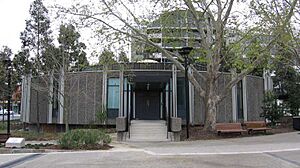
The Bankstown City Council had twelve councillors. They were elected from four different areas called "wards." Each ward elected three councillors. Councillors served for a four-year term. The mayor was chosen by the councillors at their first meeting. Khal Asfour was the last mayor before the council merged.
Geography of Bankstown
The former Bankstown City area was about 76 square kilometers. It was a busy place with many people living close together. The Georges River formed part of its southern and western borders.
Paul Keating Park is in the center of Bankstown. It is on the site of the old Council Administration building that burned down. The park is used for concerts and festivals. Today, all council work happens in the Civic Tower, next to the park.
Parks in Bankstown
Bankstown had many parks, covering a large area. There were 293 parks in total. These included sports grounds, community parks, and natural parklands. Some major parks were Bankstown Oval, McLeod Reserve, and Paul Keating Park. The entrance to Georges River National Park was also within the city.
Libraries in Bankstown
In 1946, Bankstown was the first area in Western Sydney to open a Children's Library. A main library opened in Bankstown in 1954. Later, more branch libraries opened in other suburbs like Chester Hill and Padstow.
In 2013, a new and much bigger "Bankstown Library and Knowledge Centre" opened. It is next to the Town Hall. This new library is a modern and welcoming community hub. It has won awards for its design.
Sister Cities
Bankstown had "Sister City" agreements with several places around the world. These agreements help cities share culture and ideas.
 Broken Hill, Australia (since 1986)
Broken Hill, Australia (since 1986) Suita, Japan (since 1989)
Suita, Japan (since 1989) Colorado Springs, Colorado, United States (since 2001)
Colorado Springs, Colorado, United States (since 2001) Yangcheon-gu City, South Korea (Friendship Agreement in 1997, Sister City in 2002)
Yangcheon-gu City, South Korea (Friendship Agreement in 1997, Sister City in 2002) Shijiazhuang, China (Friendship Agreement in 2000)
Shijiazhuang, China (Friendship Agreement in 2000)
Bankstown's Crest and Logo
In 1963, Bankstown Council adopted a new civic badge. It was a blue and gold shield with a white cross. It featured symbols like the Southern Cross for Australia and a lion from the Coat of Arms of New South Wales. It also included symbols from Sir Joseph Banks' own coat of arms, like a stork and a fleur-de-lis. A small crown on top represented the Queen. This crest was the main logo until 1995. Then, a new logo featuring the "Spirit of Botany" statue was used until 2016.



